This site is supported by our readers. We may earn a commission, at no cost to you, if you purchase through links.
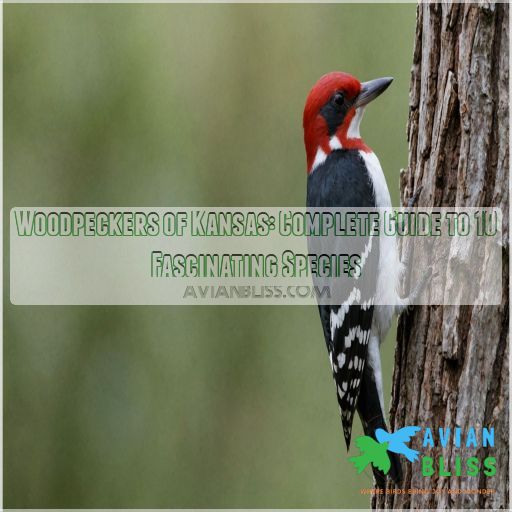
Keep an ear out for their rhythmic drumming and distinctive calls – it’s like a symphony of the forest!
Whether you spot the bold black-and-white Hairy Woodpecker or the flamboyant Northern Flicker with its golden wings, these industrious birds are a delight to observe.
And who knows, you might even catch a glimpse of the elusive Lewis’s Woodpecker, a true rarity in the Sunflower State.
Get ready to be captivated by the woodpeckers of Kansas!
Table Of Contents
- Key Takeaways
- Types of Woodpeckers in Kansas
- Characteristics of Woodpeckers in Kansas
- Habitat and Distribution of Woodpeckers
- Diet and Foraging Strategies
- Conservation Status and Threats
- Attracting Woodpeckers to Your Yard
- Identifying and Dealing With Woodpecker Problems
- Unique Characteristics of Rare Kansas Woodpeckers
- Interesting Facts About Woodpeckers in Kansas
- Frequently Asked Questions (FAQs)
- What kind of woodpeckers live in Kansas?
- Are woodpeckers good to have in your yard?
- How do you identify a woodpecker?
- What are the brown birds that look like woodpeckers?
- How do woodpeckers impact ecosystem dynamics?
- What are woodpeckers mating rituals like?
- Do woodpecker migratory patterns vary in Kansas?
- How does climate change affect woodpeckers?
- What role do woodpeckers play in controlling pests?
- Conclusion
Key Takeaways
- You’ll be amazed by the diverse array of woodpeckers in Kansas, from the vibrant Red-bellied to the diminutive Downy – keep your eyes peeled and ears perked for their rhythmic drumming and distinctive calls!
- Attracting woodpeckers to your yard is a breeze with the right plants, feeders, and nesting boxes – turn your backyard into a woodpecker wonderland and enjoy their fascinating behaviors up close!
- While woodpeckers are a delight to observe, they can sometimes cause problems like damage to buildings – but don’t worry, there are plenty of effective prevention methods and control techniques to keep the pecking at bay.
- Don’t miss out on the rare woodpecker sightings in Kansas, like the elusive lewis’s woodpecker and the Ladder-backed Woodpecker – these feathered gems offer a glimpse into nature’s incredible adaptations and diversity.
Types of Woodpeckers in Kansas
In Kansas, you’ll find both common and rare woodpeckers, each species with its unique flair and habitat preferences.
From the vibrant Red-headed Woodpecker to the elusive Ladder-backed Woodpecker, these avian drummers add plenty of rhythm to the Kansas landscape.
Common Woodpeckers
As a Kansas resident, you’re likely to spot several common woodpecker species in your backyard or local parks.
The Red-bellied Woodpecker, with its distinctive red nape and crown, is a year-round resident that feasts on insects, small fish, and even tree sap.
The Downy Woodpecker, the smallest in North America, is easily recognized by its black-and-white plumage and can be found throughout the state.
Rare Woodpeckers
Spotting rare woodpecker species in Kansas is like finding hidden treasure in your backyard.
Keep an eye out for Lewis’s Woodpecker or the Ladder-backed Woodpecker.
These fascinating birds face habitat challenges, but conservation efforts aim to turn the tide.
With woodpecker sightings becoming more treasured, learning woodpecker identification helps make sure these avian wonders continue to thrive.
Migration Patterns of Kansas Woodpeckers
Kansas woodpeckers reveal their wanderlust through synchronized dances with seasonal shifts.
Most stick around the woodpecker state year-round, appreciating familiar woodpecker forests.
However, species like the yellow-bellied sapsucker make notable appearances during migration periods.
Their breeding routes and spring arrivals are like nature’s own orchestra, fascinating those who witness their rhythmic fall departures to warmer wintering grounds.
Characteristics of Woodpeckers in Kansas
In Kansas, you’ll find a diverse array of woodpecker species, each with its own unique characteristics, from their striking plumages to fascinating mating behaviors.
You might be surprised to learn that woodpeckers don’t get headaches from all that pecking—they’re designed for it!
Identifying Woodpecker Species
Identifying the woodpecker species in Kansas is a fun challenge that’ll have you feeling like a true birding expert.
Look for key features like the head, back, and belly patterns.
Don’t forget to listen for their unique calls – from the loud "kuk-kuk-kuk" of the Red-headed to the gentle "pik" of the Downy.
- Red-headed Woodpecker
- Red-bellied Woodpecker
- Downy Woodpecker
- Hairy Woodpecker
- Northern Flicker
Size, Shape, and Plumage Variations
While identifying woodpecker species, noting size, shape, and plumage variations helps you feel more confident when observing woodpeckers in Illinois.
Picture the Red-headed Woodpecker’s crimson head or the Downy’s petite frame.
Look for beak adaptations that match each species’ feeding habits, color patterns that blend or pop, and wingspan differences that aid flight.
Each woodpecker flaunts unique feather types, showcasing nature’s brilliant design palette.
Behavioral Traits and Mating Habits
Understanding woodpecker plumage is just the tip of the iceberg. These birds also exhibit fascinating behavioral traits:
- Courtship Displays: Some woodpeckers perform elaborate drumming patterns to attract mates.
- Nest Building: Crafting a woodpecker nest involves chiseling into tree trunks.
- Chick Rearing: Parents share the duty of feeding woodpecker insects and sap.
- Territorial Defense: They drum and tap to assert control over their woodpecker tree.
Habitat and Distribution of Woodpeckers
In Kansas, woodpeckers find their homes in various habitats, from dense forests to open woodlands.
Woodpeckers favor habitats where their favorite foods like insects, seeds, and sap are abundant.
You might be surprised to learn that these industrious birds even make regular pit stops at water sources, taking the time for a quick drink between bouts of drumming on trees.
Forest Types and Woodpecker Habitats
Kansas’s diverse forests provide the perfect habitats for a variety of woodpecker species. From the lush deciduous woodlands to the towering pines, each forest type caters to the unique needs of these fascinating birds. Whether you’re exploring a state park or your own backyard, keep an eye out for these feathered friends!
| Forest Type | Woodpecker Preferences |
|---|---|
| Deciduous Forests | Red-headed, Red-bellied, Downy, Hairy |
| Pine Forests | Pileated, Red-headed, Red-bellied |
| Urban Areas | Downy, Red-bellied, Northern Flicker |
| Burned Forests | Lewis’s Woodpecker |
| Riparian Zones | American Three-toed Woodpecker |
Preferred Food Sources and Feeding Areas
Picture Kansas woodlands humming with woodpecker activity.
Different species feast on nature’s buffet: Red-headed and Red-bellied woodpeckers gobbling juicy insects and woodpecker fruits, while sapsuckers prefer tree sap.
Feathered friends face feeding competition, adjusting to insect availability and seasonal variations.
Even their noisy nestlings demand a varied woodpecker seed and insect-rich diet, contributing to the soundtrack of lively forest chatter.
Water Sources and Drinking Habits
While exploring Kansas woodpeckers’ feeding areas, don’t overlook their water habits.
These birds aren’t water-dependent like ducks, but they visit water sources for a sip now and then.
Whether it’s a birdbath or a small stream, providing fresh, clean water can attract them to your yard.
Diet and Foraging Strategies
You’ll be amazed at the variety of diets and clever foraging strategies woodpeckers in Kansas employ.
These birds are like nature’s multitaskers, chiseling away at tree trunks for insects while also playing a surprising role in seed dispersal and pollination.
Primary Food Sources
Woodpeckers in Kansas are true omnivores, with diverse diets that include insects, sap, nuts, fruits, and seeds.
They’ll feast on wood-boring beetles, ants, caterpillars, and other juicy morsels found in the bark and crevices of trees.
Acorns, berries, and sunflower seeds also make tasty treats for these adaptable birds.
Feeding Techniques and Tool Use
When hunting, woodpeckers demonstrate impressive tool use.
Their pecking techniques aren’t just mindless drumming—it’s strategic.
They chisel into bark to snag tasty insects, expertly crack seeds with a beak that’s nature’s nutcracker, and even practice sap extraction; a little tree-tapping for dessert.
They’ve got a talent for turning trees into buffet tables!
Ready for more woodpecker wonders?
Role of Woodpeckers in Seed Dispersal and Pollination
In your backyard, you’ll spot woodpeckers skillfully foraging from tree to tree, playing an indirect but important role in seed dispersal and pollination.
Their pecking assists with:
- Seed Dislodgement: Seeds fall and take root elsewhere.
- Tree Boring: Creates cavities for new growth.
- Pollen Transfer: Occasional accidental pollination.
These activities contribute to forest diversity and regeneration.
Conservation Status and Threats
When you think about the feisty woodpeckers in Kansas, it’s important to keep in mind the conservation challenges they face, like habitat loss and climate change.
By understanding these threats, you can help make sure these incredible birds stick around for future generations, and maybe even teach you a thing or two about pecking order!
Habitat Loss and Fragmentation
You may be saddened to learn that habitat loss and fragmentation pose grave threats to Kansas’s woodpeckers. As forests give way to urban sprawl, these feathered friends lose their homes. But fear not – supporting sustainable forestry and creating wildlife corridors can help reverse this trend and keep woodpeckers fluttering in your backyard.
| Threat | Impact | Solution | Timeline |
|---|---|---|---|
| Deforestation | Reduced nesting sites | Reforestation efforts | Long-term |
| Urbanization | Diminished food sources | Wildlife-friendly landscaping | Short-term |
| Habitat Fragmentation | Disrupted migration patterns | Establishing corridors | Medium-term |
| Agricultural Expansion | Loss of diverse ecosystems | Promoting agroforestry | Ongoing |
Effects of Climate Change on Woodpeckers
Shifting habitats and changing food sources—oh my! Climate change gives Kansas woodpeckers a real run for their money. Just like an uninvited guest, it’s altering migration patterns, with breeding seasons now as unpredictable as a cat in a room full of rocking chairs. Woodpecker populations are feeling the pinch, as these changes can lead to a steady decline.
Conservation Efforts and Restoration Programs
Climate change may ruffle feathers, but efforts to protect woodpeckers swoop in. Consider these:
- Habitat restoration: Give trees a comeback; they’re the heart of woodpecker real estate.
- Citizen science: Your bird notes count—keep ‘em coming!
- Sustainable forestry: What’s good for trees is good for woodpeckers.
Let’s make Kansas a woodpecker wonderland!
Attracting Woodpeckers to Your Yard
Want to turn your yard into a woodpecker paradise? With the right plants, feeders, and nesting boxes, you’ll soon enjoy the pecking rhythm of these fascinating birds.
Types of Woodpecker-Friendly Plants
To attract woodpeckers to your yard, incorporate a variety of native trees like oaks, maples, and pines that provide food and nesting sites.
Seed-bearing shrubs like serviceberry, dogwood, and sumac offer sustenance, while insect-attracting plants like milkweed and coneflowers create a buzzing habitat.
Don’t forget to leave some dead wood for foraging opportunities.
Feeding Woodpeckers: Seed Types and Feeder Options
After selecting woodpecker-friendly plants, it’s time to spice up your bird feeding game!
Use seed blends loaded with sunflower seeds and peanuts to win their hearts.
Hang suet options, adding a gourmet touch to your yard.
Try DIY feeder ideas for extra fun.
Nesting Box Design and Installation
When inviting woodpeckers to your yard, a well-designed nesting box is key. Choose durable materials and make sure the size suits your target species. Think of placement tips like keeping it away from noisy areas.
Add predator protection to safeguard your guests.
Finally, add a few attractive features like bark textures to make it irresistible to these feathered architects!
- Nesting box materials
- Placement tips
- Size recommendations
- Predator protection
- Attracting woodpeckers
Identifying and Dealing With Woodpecker Problems
You love watching woodpeckers, but when they start pecking your house, their charm fades quickly.
Let’s tackle those pesky problems with smart solutions so you can keep enjoying your feathered friends without the unwanted remodeling.
Damage to Buildings and Structures
While woodpeckers may add character to your yard, their penchant for drilling holes in wood siding, eaves, and even stucco can become a frustrating problem.
Quickly addressing any damage is key – seal up entry points, install deterrents like reflective tape or fake owls, and consider woodpecker-resistant siding materials to prevent future issues.
Conflicts With Other Birds and Pets
It’s not uncommon for woodpeckers to cause a bit of a stir in your backyard, entering a sort of intruding showdown with other birds over nesting sites or even engaging in squirrely rivalries.
They might also spook your pets with their incessant drumming.
Balancing this backyard drama can be tricky, but observing it often reveals fascinating woodpecker behavior dynamics.
Prevention Methods and Control Techniques
Sometimes, dealing with woodpecker problems can feel like trying to stop a train with your bare hands.
Effective prevention is possible with the right tools:
- Install visual deterrents like reflective tape.
- Use exclusion techniques such as netting.
- Apply natural repellents like pepper sprays.
- Modify habitats by trimming trees or removing attractants.
Feeling deterred yet, you bold pecker?
Unique Characteristics of Rare Kansas Woodpeckers
Discover the unique traits of Kansas’s rare woodpeckers, including Lewis’s Woodpecker, Ladder-backed Woodpecker, and Williamson’s Sapsucker, whose birdwatching experiences will make you want binoculars permanently glued to your face.
These special birds offer a fascinating glimpse into nature’s innovation as they adapt to unusual habitats, feeding habits, and more, making them a must-see on any birdwatcher’s list.
Lewis’s Woodpecker and Its Adaptations
The Lewis’s Woodpecker is a true marvel of nature. This rare bird boasts a bulky, pink-hued body, a striking red face, and remarkable adaptations for its unique lifestyle. Its broad, rounded wings and efficient foraging techniques allow it to effortlessly snatch insects mid-flight, making it a sight to behold in the skies of Kansas.
| Adaptation | Description |
|---|---|
| Flight | Broad, rounded wings for efficient aerial maneuverability |
| Foraging | Skilled at catching flying insects in mid-air |
| Plumage | Distinctive pink body and red facial features |
| Habitat | Prefers burned forests, ponderosa pine, orchards, and woodlands |
| Conservation | Rare visitor to Kansas, requiring habitat preservation efforts |
The Lewis’s Woodpecker is a rare visitor to Kansas, requiring habitat preservation efforts.
Ladder-Backed Woodpecker’s Special Features
Enjoy spotting the rare Ladder-backed Woodpecker in Kansas, mainly in the state’s southwestern corner.
This bird features a "ladder" pattern on its back and a bold red crown.
Inhabit open woodland habitats and feed on insects with a flair for sunflower seeds and peanut butter.
Embrace their presence while practicing conservation to support their habitat and diet.
Williamson’s Sapsucker and Its Habits
Williamson’s Sapsuckers are like winter ninjas of Kansas, occasionally spotted during colder months.
Their migration patterns are a little mysterious, adding an air of intrigue.
Breeding season is a busy time, with males boasting vibrant plumage.
They cleverly nest in cavities of dead trees—nature’s apartment buildings, if you will.
Keep an eye out for these elusive sapsuckers!
Interesting Facts About Woodpeckers in Kansas
Discover the fascinating world of woodpeople in Kansas, where these expressive and intelligent birds do more than just peck around.
As they grapple life hands-on, watch them chisel out a rock-solid life while facing all sorts of challenges.
Courtship Rituals and Mating Behaviors
Courtship among woodpeckers is a fascinating dance, a symphony of rhythmic drumming and vibrant displays. Observe as males showcase their prowess, drumming on hollow trees to attract potential mates. Females may respond with head-bobbing, wing-flicking, and other alluring gestures, evaluating suitors before selecting their lifelong partner. This intricate mating ritual is a true example of the ingenuity of these remarkable birds.
- Rhythmic drumming on hollow trees
- Head-bobbing and wing-flicking displays
- Evaluating potential mates through visual cues
- Lifelong pair-bonding after successful courtship
Peculiar Foraging and Drinking Habits
Spot a woodpecker tapping; it’s like they’re drumming a mysterious woodland symphony.
These birds have fascinating sap-sucking techniques that keep them fueled.
When they’re not sipping tree sap, they’re foraging for bugs with distinct sounds echoing through the trees.
Need a drink? They often lap up water droplets on leaves.
It’s a wild world they navigate, surviving winters with resourceful foraging.
Interesting Nesting and Breeding Practices
Under the canopy of Kansas woodlands, woodpeckers prepare nesting cavities with precision, like nature’s carpenters.
During the breeding season, they become fierce defenders of territory, choosing mates with intricate courtship rituals.
Young care is a family affair; parents tirelessly feed their chicks. It’s a delicate dance of life where survival hinges on proper nest choice and relentless perseverance.
Frequently Asked Questions (FAQs)
What kind of woodpeckers live in Kansas?
Imagine Kansas as a stage, with woodpeckers dancing year-round; you’ve got Red-headed, Red-bellied, Downy, Hairy, and Northern Flicker common as jazz, while Lewis’s and Three-toed add rare notes to this avian symphony.
You’ve got Red-headed, Red-bellied, Downy, Hairy, and Northern Flicker common as jazz,
while Lewis’s and Three-toed add rare notes to this avian symphony.
Are woodpeckers good to have in your yard?
Woodpeckers are great to have in your yard!
They’re nature’s pest control, gobbling up insects like a natural exterminator.
Plus, they create cozy hideouts for other critters by hollowing out tree cavities, enhancing your backyard’s biodiversity .
How do you identify a woodpecker?
Identifying a woodpecker is a snap – just look for their signature drumming, bright plumage, and acrobatic antics as they scale tree trunks.
With a keen eye, you’ll spot these feathered carpenters in no time!
What are the brown birds that look like woodpeckers?
You might be thinking of flickers, which are woodpeckers with brown feathers.
Northern Flickers, seen year-round in Kansas, boast brown barred backs and a curious nature—like that neighbor who always peeks over the fence.
How do woodpeckers impact ecosystem dynamics?
Imagine woodpeckers as nature’s architects, carefully sculpting trees, which creates habitats for other animals.
Through their drilling, they control insect populations, balance ecosystems, and facilitate new growth.
Their work sounds like tapping into nature’s harmony, doesn’t it?
What are woodpeckers mating rituals like?
Woodpecker courtship is a tap dance of sorts.
Males drum rhythmically on trees to attract mates.
Then, they pair up to excavate a cozy nest cavity.
This ensures their future family gets excellent real estate.
Do woodpecker migratory patterns vary in Kansas?
Woodpecker migratory patterns in Kansas vary, with some species like the Red-bellied and Downy Woodpeckers remaining year-round, while others like the Yellow-bellied Sapsucker migrate seasonally.
How does climate change affect woodpeckers?
Climate change hits harder than a woodpecker’s beak, altering habitats and food sources.
You may notice shifts in migration patterns and the timing of nesting seasons, challenging woodpeckers’ survival and demanding efforts for conservation.
What role do woodpeckers play in controlling pests?
You might not realize it, but by munching on insects, these avian carpenters act as natural pest controllers.
They’re like little exterminators, keeping forests healthy by reducing harmful pests that could otherwise damage trees .
Conclusion
Picture yourself as a ‘nature detective’ unraveling the mysteries of the woodpeckers of Kansas.
Each peck and drumbeat is a clue, revealing the vibrant life of the Sunflower State’s feathered architects.
From their striking plumage to their clever foraging techniques, these birds are as fascinating as a well-played game of Clue.
You’ve got everything you need now to appreciate and preserve these remarkable creatures—so grab your magnifying glass (or binoculars) and start exploring!
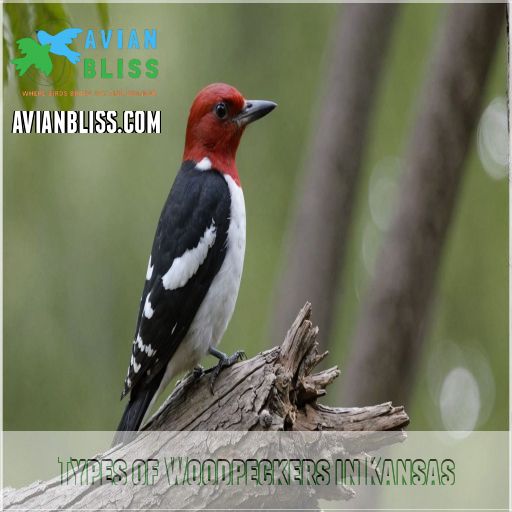
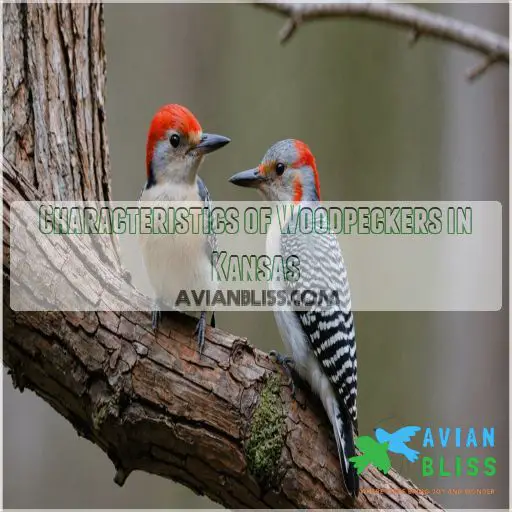
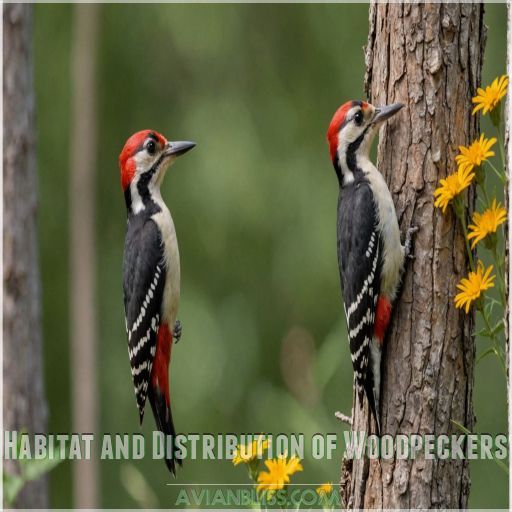
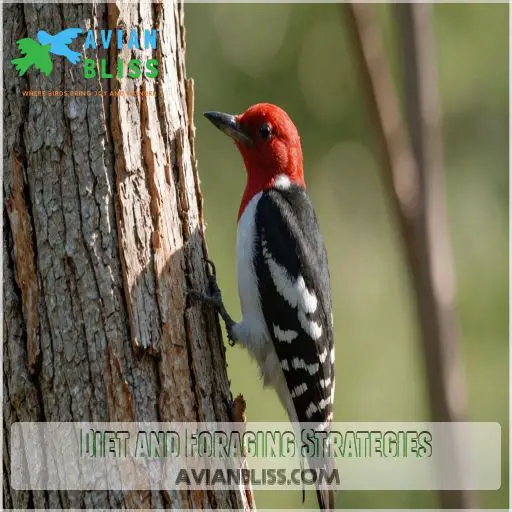





0 Comments